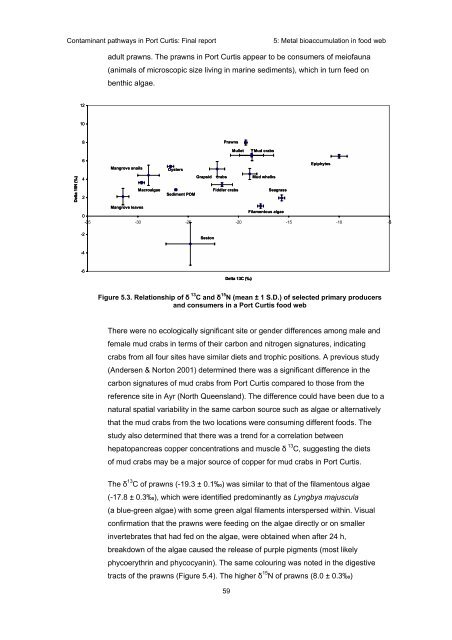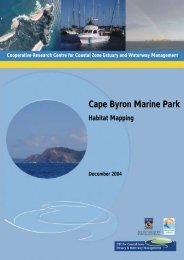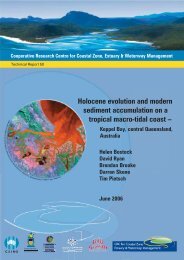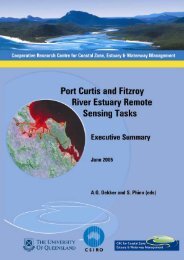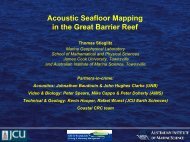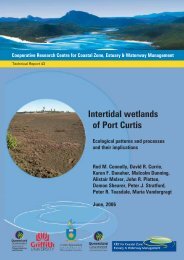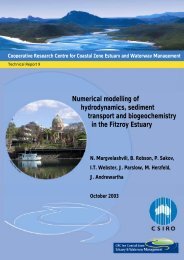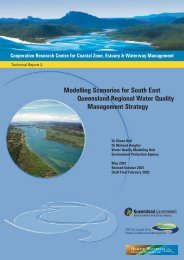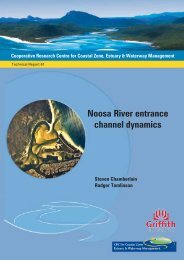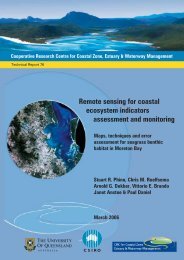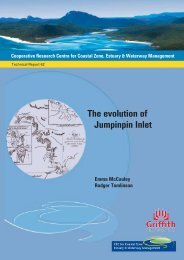Contaminant pathways in Port Curtis: Final report - OzCoasts
Contaminant pathways in Port Curtis: Final report - OzCoasts
Contaminant pathways in Port Curtis: Final report - OzCoasts
You also want an ePaper? Increase the reach of your titles
YUMPU automatically turns print PDFs into web optimized ePapers that Google loves.
<strong>Contam<strong>in</strong>ant</strong> <strong>pathways</strong> <strong>in</strong> <strong>Port</strong> <strong>Curtis</strong>: F<strong>in</strong>al <strong>report</strong>5: Metal bioaccumulation <strong>in</strong> food webadult prawns. The prawns <strong>in</strong> <strong>Port</strong> <strong>Curtis</strong> appear to be consumers of meiofauna(animals of microscopic size liv<strong>in</strong>g <strong>in</strong> mar<strong>in</strong>e sediments), which <strong>in</strong> turn feed onbenthic algae.12108PrawnsMulletMud crabs6Mangrove snailsOystersEpiphytesDelta 15N (‰)42MacroalgaeGrapsidcrabsFiddler crabsSediment POMMud whelksSeagrassMangrove leavesFilamentous algae0-35 -30 -25 -20 -15 -10 -5-2Seston-4-6Delta 13C (‰)Figure 5.3. Relationship of δ 13 C and δ 15 N (mean ± 1 S.D.) of selected primary producersand consumers <strong>in</strong> a <strong>Port</strong> <strong>Curtis</strong> food webThere were no ecologically significant site or gender differences among male andfemale mud crabs <strong>in</strong> terms of their carbon and nitrogen signatures, <strong>in</strong>dicat<strong>in</strong>gcrabs from all four sites have similar diets and trophic positions. A previous study(Andersen & Norton 2001) determ<strong>in</strong>ed there was a significant difference <strong>in</strong> thecarbon signatures of mud crabs from <strong>Port</strong> <strong>Curtis</strong> compared to those from thereference site <strong>in</strong> Ayr (North Queensland). The difference could have been due to anatural spatial variability <strong>in</strong> the same carbon source such as algae or alternativelythat the mud crabs from the two locations were consum<strong>in</strong>g different foods. Thestudy also determ<strong>in</strong>ed that there was a trend for a correlation betweenhepatopancreas copper concentrations and muscle δ 13 C, suggest<strong>in</strong>g the dietsof mud crabs may be a major source of copper for mud crabs <strong>in</strong> <strong>Port</strong> <strong>Curtis</strong>.The δ 13 C of prawns (-19.3 ± 0.1‰) was similar to that of the filamentous algae(-17.8 ± 0.3‰), which were identified predom<strong>in</strong>antly as Lyngbya majuscula(a blue-green algae) with some green algal filaments <strong>in</strong>terspersed with<strong>in</strong>. Visualconfirmation that the prawns were feed<strong>in</strong>g on the algae directly or on smaller<strong>in</strong>vertebrates that had fed on the algae, were obta<strong>in</strong>ed when after 24 h,breakdown of the algae caused the release of purple pigments (most likelyphycoerythr<strong>in</strong> and phycocyan<strong>in</strong>). The same colour<strong>in</strong>g was noted <strong>in</strong> the digestivetracts of the prawns (Figure 5.4). The higher δ 15 N of prawns (8.0 ± 0.3‰)59


